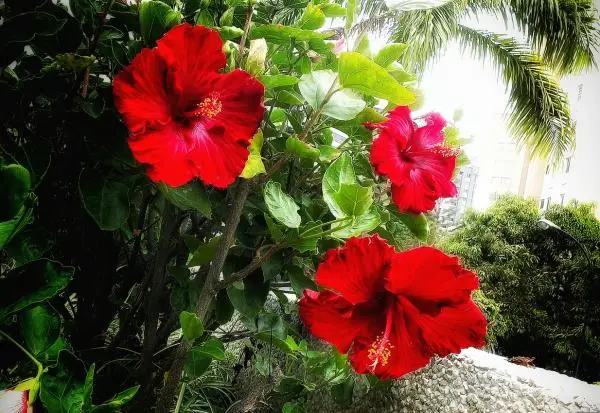The one known as the Jamaica plant is a plant with beautiful flowers, highly valued as an ornamental plant but even more popular for its culinary and medicinal uses, which have led to the appearance of a large number of infusions, soft drinks, and other products with its more than 150 varieties.
If you want to know what the Jamaica flower is like and learn more about its different crops, join us in this article about the types of Jamaica flower and their care.
Characteristics and uses of the Jamaica flower
Scientific name Hibiscus sabdariffa, this plant of the Malvaceae family has its habitat of origin on the African continent. It is an annual and evergreen shrubby plant that reaches heights of up to 3 meters, although it is also common to see it much smaller.
It is a plant widely used and cultivated for commercial purposes throughout the world since both its flowers and its fruits have a huge number of known uses. These are the best-known uses and properties of the Jamaica flower:
- Food: in countries such as Jamaica and Mexico and some parts of Central, South America and the Caribbean, the economic cost of this plant allows a wide range of products to reach consumers of any purchasing power. When fresh, it is common to make both hot and cold beverages and macerated, and its flowers and leaves are commonly added to salads, sauces, preserves and pastry recipes. With its chalices compotes, jellies, jellies, sweets, ice creams and liqueurs are made.
- Medicinal: traditional medicine recognizes multiple properties of this plant, to which properties are attributed that help in treatments against hypertension, as a diuretic element, against liver diseases, in the fight against cholesterol, as an intestinal antiseptic, as an antioxidant and even as a powerful ally against insomnia in the form of an infusion. It also helps regulate insulin, treat hemorrhoids and varicose veins, and has anticancer properties.
- Industrial: the chalice is used as a colorant in the process of coloring cosmetics, perfumes, textiles, handicrafts, medicines, and even foods. Its use of this type is particularly widespread in France and Germany. In addition, a highly valued oil is also made with the Jamaican seed. With its stem, thanks to its fibers, twine similar to those of jute and hemp are also made and, finally, the flower is common for the production of poultry feed and organic manure.
Types of Jamaica flower
The large number of existing Jamaican crops has given rise to around 200 varieties of this flowering plant, although they can be classified into two main types, one with erect stems, spiny and without branches, very rich in fiber and used in the elaboration of string, and the other with highly branched stems and a juicier calyx, more gastronomically popular.
- The first is called H. sabdariffa sabdariffa L. It is about plants that can grow up to 2 meters in height, with varieties such as the so-called chirrión.
- The second is called H. sabdariffa altissima , commonly called roselli hemp, which groups together all the varieties used to obtain fiber.
In addition to those mentioned, there are some varieties with more international presence, such as:
- La Rica , of short height and bearing but great production capacity, which produces flowers with very red and large calyxes, originally from Nicaragua.
- Originally from the same country we also have the Víctor , of great reddish color and stems of marked vigor, used especially in the production of fruits and calyxes.
- Another variety is the Archer , of the so-called greenish, of great vigor and production capacity.
- The Temprano is one of the most precocious of all, as its name indicates, which also gives a good yield of fruits and flowers.
To finish, these are other varieties of Jamaica flowers, but remember that there are about 200.
- Red
- Giant black
- Giant abode
- Not acidic
- Creole
- Long red
- China
- Jerzy
- Sudan

Jamaica flower care
Despite how widespread its cultivation is, the Jamaica flower has some very marked needs as a plant of tropical and subtropical origin that it is, so you have to pay attention to its care if your climate does not meet these characteristics. These are your most important needs:
- Climate : temperatures between 20ºC and 28ºC. It does not tolerate low temperatures for long periods, and contact with snow is generally fatal. High temperatures throughout the year will allow the plant to not stop blooming.
- Humidity : below 70%, higher humidity will be harmful.
- Light : it needs a large amount of direct sunlight throughout the day, especially during the vegetative development period. Its cultivation indoors is unfeasible.
- Watering : every 48 hours in the warm months, up to once a week in the cold. Deep watering.
- Substrate and soil : aerated, light, well drained and very rich in nutrients.
